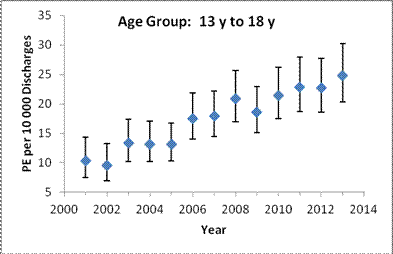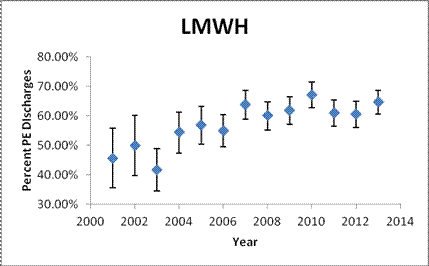Abstract

Background: Pulmonary embolism (PE) as a form of venous thromboembolism (VTE) is rare in children, but causes high morbidity and mortality when it occurs. Recent evidence has shown that the incidence of VTE in pediatric tertiary care hospitals has increased over the past 10 years, but the authors did not specifically evaluate PE [Raffini L, et al. Pediatrics 2009]. Utilizing the Pediatric Health Information System (PHIS) database, we sought to evaluate the incidence, treatment and outcome of PE in children over the last decade.
Methods: This retrospective study reviewed pediatric patients within the PHIS database diagnosed with PE from 2001 to 2013. Demographics, including type of payer, initial treatment, length of stay, mortality, recurrence and associated chronic illness were included in the analysis. Inclusion criteria were discharge diagnosis codes for PE (415.11, 415.12, 415.19) and age less than 18 years. Demographic characteristics between those admitted with VTE alone vs. those with PE were compared using chi-square or Wilcoxon-rank sum analysis as appropriate. Rates of PE by year were calculated by dividing the number of PE admissions by the total number of hospital admissions and VTE admissions. Age groups were analyzed separately. Trends in medication use were analyzed using generalized estimating equations (GEE), assuming a first-order autoregressive covariance structure across years within the same hospital.
Results: Over the period of the study, patients discharged with a diagnosis of PE (n=4,161) made up 15.5% of all pediatric discharges with VTE (n=26,909). The overall rate of PE increased by 184% from 2001 to 2013 (p=<0.001). Compared to all other age groups, adolescents (age 13-18 yrs) were the most likely to present with PE (55%, p<0.001). [Table] Additionally the rate of PE in this age group increased from 10.3 to 24.8 per 10,000 hospital discharges, a 140% increase (p<0.001), and from 17.9 to 36.5 per 100 VTE discharges, a 104% increase (p<0.001). [Figure 1] Individuals with PE were less likely to have a complex chronic condition (CCC) than those with VTE alone [CCC 58% PE vs. 65% VTE, p<0.001]. Those with PE had a higher mortality than those with VTE alone [8.5% vs. 6%, p<0.001]. Black and Hispanic patients were more likely to experience a recurrent PE than Caucasians (11.6% and 9% vs. 7.5% p<0.001). Over the period of the study, unfractionated heparin use decreased (p<0.001) and low molecular weight heparin (LMWH) use increased (p=0.001). [Figures 2 and 3]
Conclusions: The rate of PE in children is increasing, particularly in the adolescent age group. The population of children with PE is different than that with VTE alone. From the PHIS data, it appears that they are more likely to be adolescents and less likely to have a complex chronic condition. Black and Hispanic patients appear to be at greater risk of recurrent PE. Treatment of PE has evolved over the past decade with greater use of LMWH compared to unfractionated heparin. Further research is required to determine what factors are contributing to the rapid increase in PE in the adolescent population and which influence the risk of recurrence in certain ethnic populations.
| . | . | All VTE Discharges (%) (N=26,910) . | Discharges w/o PE (%) (N=22,748) . | Discharges w/ PE (%) (N=4,162) . | p-value . |
|---|---|---|---|---|---|
| Age | <0.001 | ||||
| a. <28 d | 3,756 (14) | 3,523 (15.5) | 233 (5.6) | ||
| b. 29 d to <1 y | 3,912 (15) | 3,563 (15.7) | 349 (8.4) | ||
| c. 1 to <6 y | 5,262 (20) | 4,736 (20.8) | 526 (12.6) | ||
| d. 6 to <13 y | 5,163 (19) | 4,409 (19.4) | 754 (18.1) | ||
| e. 13-18 y | 8,817 (33) | 6,517 (28.6) | 2,300 (55.3) | ||
| Gender | 0.006 | ||||
| a. Male | 14,544 (54) | 12,375 (54.4) | 2,169 (52.1) |
| . | . | All VTE Discharges (%) (N=26,910) . | Discharges w/o PE (%) (N=22,748) . | Discharges w/ PE (%) (N=4,162) . | p-value . |
|---|---|---|---|---|---|
| Age | <0.001 | ||||
| a. <28 d | 3,756 (14) | 3,523 (15.5) | 233 (5.6) | ||
| b. 29 d to <1 y | 3,912 (15) | 3,563 (15.7) | 349 (8.4) | ||
| c. 1 to <6 y | 5,262 (20) | 4,736 (20.8) | 526 (12.6) | ||
| d. 6 to <13 y | 5,163 (19) | 4,409 (19.4) | 754 (18.1) | ||
| e. 13-18 y | 8,817 (33) | 6,517 (28.6) | 2,300 (55.3) | ||
| Gender | 0.006 | ||||
| a. Male | 14,544 (54) | 12,375 (54.4) | 2,169 (52.1) |
p<0.001
p<0.001
p=0.001
Off Label Use: Treatment of PE with anticoagulants including tPA and novel anticoagulants..
Author notes
Asterisk with author names denotes non-ASH members.

This icon denotes a clinically relevant abstract




This feature is available to Subscribers Only
Sign In or Create an Account Close Modal